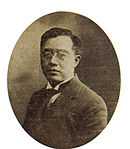Kim Kyu-sik
| Kim Kyu-sik 김규식 金奎植 | |
|---|---|
 | |
| Vice President of the Provisional Government of the Republic of Korea | |
| In office October 1940 – March 3, 1947 | |
| Preceded by | - |
| Succeeded by | Kim Gu |
| Personal details | |
| Born | January 29, 1881 Dongrae, Joseon Dynasty |
| Died | December 10, 1950 (aged 69) Manpo, North Korea |
| Korean name | |
| Hangul | 김규식 |
|---|---|
| Hanja | 金奎植 |
| Revised Romanization | Gim Gyu-sik |
| McCune–Reischauer | Kim Kyu-sik |
| Pen name | |
| Hangul | 우사, 죽적 |
| Hanja | 尤史, 竹笛 |
| Revised Romanization | Wusa, Jukjoek |
| McCune–Reischauer | Usa, Jookjeok |
| Courtesy name | |
| Hangul | 변갑 |
| Revised Romanization | Byongap |
| McCune–Reischauer | Byeongab |
Kim Kyu-Sik, also spelled Kimm Giusic and Kimm Kiusic (Korean:김규식, Hanja:金奎植, January 29, 1881 - December 10, 1950), was a Korean politician and academic during the Korean independence movement and a leader of the Provisional Government of the Republic of Korea. Kim served in various roles in the provisional government, including as foreign minister, ambassador, education minister and finally as the vice president from 1940 until the provisional government's dissolution on March 3, 1947. Kim's nicknames included Yoosa(우사), Kummun(금문), KimSung(김성), and JukJeok(죽적).
Life and career
Early life

Kim was born in Dongnae, now part of modern day Busan. Orphaned at an early age, Kim studied with American missionary H.G. Underwood starting from the age of 6, taking the Christian name "Johann." He later traveled to the United States, receiving a bachelor's degree from Roanoke College in 1903 and a master's degree in English literature from Princeton University the following year.
In 1905 Kim returned to Korea, teaching widely. Following the 1910 Japanese annexation of Korea Kim fled to China in 1913.
Provisional Government of the Republic of Korea

In 1919, unlike his contemporary Syngman Rhee, Kim successfully travelled to Paris for the Paris Peace Conference to lobby for Korean independence from Japan. He was sent by Lyuh Woon-Hyung and Chang Duk-soo, who had organized Sinhan Cheongnyeondang in Shanghai in the summer of 1919.[1] His efforts in Paris proved to be futile.
He was a leading member of the Provisional Government of the Republic of Korea based in Shanghai, becoming the Vice-President. He was fluent in English and taught English to the Provisional Government's members.
After Korean Liberation
After the liberation of Korea in 1945, he returned to his homeland to participate in the formation of a newly independent state, which was now under the rule of the United States Army Military Government in Korea in the south and the Soviet Civil Authority in the North. Kimm was favored by the American occupation leader John R. Hodge, who saw him and Lyuh Woon-Hyung as moderate leaders on the right and left, respectively. In September 1947, the United States, Lee Seung Man (이승만; 李承晩 - also known as Syngman Rhee) et al. pushed to move the Korean question to the newly created United Nations, which quickly the voted to allow for elections in the south despite. But was the objections of southern nationalists such as Kimm and Kim Gu as well as from the north's Interim People's Committee, who were opposed because of the non-participation of the North.[1]
Death
After failed efforts to broker reunification in that year, he retired from politics. After the outbreak of the Korean War in 1950, he was kidnapped and taken to the North; he reportedly died near Manpo in the far north on December 10.
In May 1988 He was posthumously awarded the Republic of Korea Medal of Order of Merit for National Foundation (건국훈장 대한민국장; 建國勳章 大韓民國章), the most prestigious civil decoration in the Republic of Korea. He was posthumously awarded North Korea's National Reunification Prize in 1998.[2]
Books
- Poems, 《YangjaYuKyung》(양자유경)
- 《Small English grammar》
- 《Practical English》
- 《Elizabeth I Age's Introduction to Theatre》
- 《WonYongSa》
Degrees
- 1903 Roanoke College(Bachelor of Arts)
- 1904 Master of English Literature(MA) at Princeton University
- 1923 Honorary Doctor of Law Roanoke College
Awards, Recognition
Notes
- ↑ 1.0 1.1 Eckert, Carter J., Lee, Ki-baik, Lew, Young Ick, Robinson, Michael & Wagner, Edward W. (1990). Korea old and new. Seoul: Ilchokak.
- ↑ "National Reunification Prize Winners", Korean Central News Agency, 1998-05-07, retrieved 2012-09-13
| Wikimedia Commons has media related to Kim Kyu-sik. |
See also
- Provisional Government of the Republic of Korea
- National Revolutionary Party
- Korea under Japanese rule
- USAMGIK
- Kim Gu
- Kim Seong-su
- Kim Won-bong
- Pak Hon Yong
- List of Koreans
Career Education
- December 17, 1913 in Shanghai, a professor of Barkdal English School
- 1923 professor of English at Fudan University
- 1927-1929 In Tianjin, Northern Sea University Professor of English
- 1932 - 1937 Nanjing political instructor School, professor of political.
- 1937 - 1940 ShChwan College Professor of English Literature, Foreign Languages and Chair, Head of Foreign Language and Literature
Further reading
- (Korean) In Korean language online encyclopedias:
| Political offices | ||
|---|---|---|
| Preceded by |
Vice Presidents of Provisional Government of the Republic of Korea 1940-1948 |
Succeeded by Provisional Government dissolved |